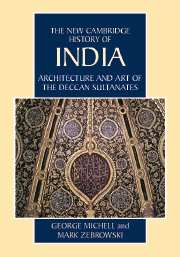Book contents
- Frontmatter
- Introduction
- 1 Historical framework
- 2 Forts and palaces
- 3 Mosques and tombs
- 4 Architectural decoration
- 5 Miniature painting: Ahmadnagar and Bijapur
- 6 Miniature painting: Golconda and other centres
- 7 Textiles, metalwork and stone objects
- 8 Temples
- 9 Conclusion
- Appendix: Dynastic Lists of Deccan Rulers
- Bibliographic Essay
- Bibliography
- Index
- Map of the Southern Deccan"
- Plate Section"
Bibliographic Essay
Published online by Cambridge University Press: 28 March 2008
- Frontmatter
- Introduction
- 1 Historical framework
- 2 Forts and palaces
- 3 Mosques and tombs
- 4 Architectural decoration
- 5 Miniature painting: Ahmadnagar and Bijapur
- 6 Miniature painting: Golconda and other centres
- 7 Textiles, metalwork and stone objects
- 8 Temples
- 9 Conclusion
- Appendix: Dynastic Lists of Deccan Rulers
- Bibliographic Essay
- Bibliography
- Index
- Map of the Southern Deccan"
- Plate Section"
Summary
historical framework
The history of the Deccan in the centuries covered in this volume is well served by a number of comprehensive studies, but many dealing with political and military history are now of some age. Essential bibliographies are provided by Khalili (1985, 1987). Persian and Arabic epigraphic sources are summarised in Desai (1989, n.d.) and various volumes of Epigraphia Indica, Arabic and Persian Supplement and Epigraphia Indo-Moslemica.
The Sultanate period is surveyed by Haig (1907, 1928), Briggs (1909–10), Venkataramana (1942) and Sherwani and Joshi (1973), the last with excellent historical chapters by various authors concentrating on the diVerent Sultanate kingdoms. Social, religious and cultural aspects of the Sultanate courts are considered by Ahmad (1953), Nizami (1974), Alavi (1977), Eaton (1978, 1998), Ernst (1992, 1993), Bredi (1993), Naqvi (1993) and Wink (1993).
Several specialised studies focus on individual Sultanates. For the Bahmanis see King (1900), Sherwani (1953), Sinha (1964), Husaini (1966) and Siddiqi (1989). Biographies of inXuential Bahmani Wgures such as Tajuddin Firuz and Mahmud Gawan are given in Sherwani (1942, 1943–4). An account of the NizamShahis is provided by Haig (1920–3) and Shyam( 1966). Malik Ambar, eVective ruler of Ahmadnagar at the turn of the seventeenth century, is the subject of Seth (1957), Shyam (1968) and Tamaskar (1978). For the Adil Shahis see Nayeem( 1974) and Verma (1974, 1990). Ibrahim Adil Shah’s career is outlined by Joshi (1948), but see Ghani (1930) and Ahmad (1956) for additional sources. Rocco (1920), Minorsky (1955), Siddiqi (1956) and Sherwani (1974) oVer historical materials relevant to the Qutb Shahis, while Sherwani (1957, 1967) takes a detailed look at the career of Muhammad Quli Qutb Shah, founder of the dynasty. The Faruqis of Khandesh, on the northern fringe of the region, are surveyed by Haig (1918) and Shyam (1981).
- Type
- Chapter
- Information
- Architecture and Art of the Deccan Sultanates , pp. 278 - 281Publisher: Cambridge University PressPrint publication year: 1999

